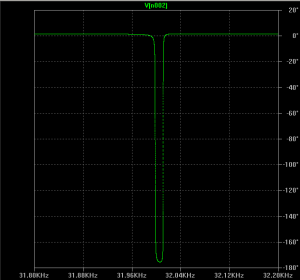Summary of Making my 32kHz Crystal Oscillator Actually Oscillate
The article discusses troubleshooting and understanding a 32kHz crystal oscillator circuit. The author explains that for oscillation, an amplifier with gain >1 and 360° phase shift (including 180° from the transistor inverter and 180° from the crystal network) is needed. Initial issues included transistor saturation and incorrect biasing, which were fixed by adjusting resistors to achieve linear operation. Simulation using LTspice modeled the crystal's unique motional parameters, such as extremely high inductance (24,000 H) and minuscule capacitance (1 fF). The author emphasizes the importance of correct biasing and supply voltage for oscillation startup.
Parts used in the 32kHz Crystal Oscillator project:
- Transistor (2N3904)
- Crystal (32kHz)
- Collector resistor (6.8kΩ)
- Base bias resistor (1.8MΩ)
- Power supply (5V adjustable)
It wouldn’t go. I messed about changing component values for while, then decided to actually try to understand the circuit. Now for an oscillator to work, we need an amplifier with a gain of greater than 1, and a phase shift of 360 degrees to get positive feedback.
The circuit above is an amplifier, with the crystal network connected between the collector output and base input. We get half of the 360 degree phase shift by using a common emitter topology, which is an inverting amplifier. So the crystal network must provide the other 180 degrees. On a good day. If it’s working.
First problem – the transistor was saturated, with Vc stuck near 0V. For an oscillator to start noise gets amplified, filtered by the crystal, amplified again etc. I reasoned that if the amplifier wasn’t biased to be linear, the oscillations couldn’t build up. So I reduced the collector resistor to 6.8k, and changed the the base bias resistor to 1.8M to get the collector voltage into a linear region. So now we have Vc=3.2V with a 5V supply.
But it still wouldn’t go. On a whim I adjusted the supply voltage up and then down and found it would start with a supply voltage beneath 3V, but not any higher. Huh?
Much fiddling with pencil and paper followed. Time for a LT Spice simulation of the “AC model” of the circuit:
I’ve “opened the loop”, to model the collector driving the crystal network which then drives the base impedance. On the left is a voltage source and 6.8k resistor that represents the collector driving the 330k resistor and an equivalent model of the crystal.
The values Lm, Cm, Rm, are the “motional” parameters. They are what the mechanical properties of the crystal look like to this circuit. The values are amazing, unrealizable if you are used to regular electronic parts. I found Cm = 1fF (1E-15 Farads, or 0.001 pF) in a 32kHz crystal data sheet, then solved f=1/(2*pi*sqrt(LC)) for Lm to get the remarkable value of 24,000 Henrys. Wow.
Phase Shift
With Vcc=5V, we have Vc=3.2V, so a collector current Ic = (5-3.2)/6800 = 0.265mA. I’m using a small signal transistor model, with the emitter resistance re=26/Ic = 26/0.265 = 100 ohms. The effective impedance looking into the base rb=beta*re = 100*100 = 10k ohms (2N3904’s have a minimum beta of 100).
For more detail: Making my 32kHz Crystal Oscillator Actually Oscillate
